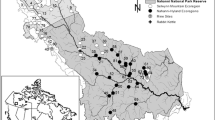Abstract
Benthic algal assemblages, water chemistry, and habitat were characterized at 25 stream sites in the Willamette Basin, Oregon, during low flow in 1994. Seventy-three algal samples yielded 420 taxa — mostly diatoms, blue-green algae, and green algae. Algal assemblages from depositional samples were strongly dominated by diatoms (76% mean relative abundance), whereas erosional samples were dominated by blue-green algae (68% mean relative abundance).
Canonical correspondence analysis (CCA) of semiquantitative and qualitative (presence/absence) data sets identified four environmental variables (maximum specific conductance, % open canopy, pH, and drainage area) that were significant in describing patterns of algal taxa among sites. Based on CCA, four groups of sites were identified: streams in forested basins that supported oligotrophic taxa, such as Diatoma mesodon;small streams in agricultural and urban basins that contained a variety of eutrophic and nitrogen-heterotrophic algal taxa; larger rivers draining areas of mixed land use that supported planktonic, eutrophic, and nitrogen-heterotrophic algal taxa; and streams with severely degraded or absent riparian vegetation (> 75% open canopy) that were dominated by other planktonic, eutrophic, and nitrogen-heterotrophic algal taxa. Patterns in water chemistry were consistent with the algal autecological interpretations and clearly demonstrated relationships between land use, water quality, and algal distribution patterns.
Similar content being viewed by others
Explore related subjects
Discover the latest articles and news from researchers in related subjects, suggested using machine learning.References
Anderson, C.W., Wood, T.M., and Morace, J.: 1997, Distribution of dissolved pesticides and other water quality constituents in small streams, and their relation to land use, in the Willamette River Basin, Oregon, 1996, U.S. Geological Survey Water-Resources Investigations Report, 97-4268, 87 pp.
American Public Health Association: 1989, Standard methods for the examination of water and wastewater (17th ed.), American Public Health Association, Washington, DC, 1136 p.
Burkholder, J.M.:1996, ‘Interactions of benthic algae with their substrata' in Algal Ecology’ Freshwater Benthic EcosystemsStevenson, R.J., Bothwell, M.L. and Lowe, R.L. (eds.), Academic Press, San Diego, CA.
Clarke, S.E., White, D. and Schaedel, L.L.: 1991, ‘Oregon, USA, ecological regions and subregions for water quality management' Environmental Management 15(6), 847–856.
Crepeau, K.L., Domagalski, J.L. and Kuivila, K.M.: 1994, Methods of analysis and quality-assurance practices of the U.S. Geological Survey Organic Laboratory, Sacramento, California-Determination of pesticides in water by solid-phase extraction and capillary-column gas chromatography/mass spectrometry, U.S. Geological Survey Open-File Report 94–362.
Cuffney, T.F., Meador, M.R., Porter, S.D. and Gurtz, M.E.: 1997, Distribution of fish, benthic invertebrate, and algal communities in relation to physical and chemical conditions, Yakima River Basin, Washington, 1990U.S. Geological Survey Water Resources Investigations Report 96–4280.
Gurtz, M.E.: 1993, ‘Design of biological components of the National Water-Quality Assessment (NAWQA) Program’ in: Biological monitoring of aquatic systemsLoeb, S.L. and Spacie, A. (eds.), Lewis Publishers, Boca Raton, FL, pp. 323–354.
Hill, W.R. and Knight, A.W.: 1988, ‘Nutrient and light limitation of algae in two northern California streams’ Journal of Phycology 24, 125–132.
Leland, H.V.: 1995, ‘Distribution of phytobenthos in theYakima River Basin,Washington, in relation to geology, land use, and other environmental factors’ Canadian Journal of Fisheries and Aquatic Sciences 52, 1108–1129.
Meador, M.R., Hupp, C.R., Cuffney, T.F. and Gurtz, M.E.: 1993, Methods for characterizing stream habitat as part of the National Water-Quality Assessment Program, U.S. Geological Survey Open-File Report 93–408.
Omernik, J.M. and Gallant, A.L.: 1986, Ecoregions of the Pacific Northwest (with map)EPA/600/3-86/033, U.S. Environmental Protection Agency, Corvallis, OR, 39 p.
Palmer, C.M.: 1969, ‘A composite rating of algae tolerating organic pollution’ Journal of Phycology 5, 78–82.
Pan, Y., Stevenson, R.J., Hill, B.H., Herlihy, A.T. and Collins, G.B.: 1996, ‘Using diatoms as indicators of ecological conditions in lotic systems: a regional assessment’ Journal of the North American Benthological Society 15(4), 481–495.
Porter, S.D., Cuffney, T.F., Gurtz, M.E. and Meador, M.R.: 1993, Methods for collecting algal samples as part of the National Water-Quality Assessment Program, U.S. Geological Survey Open-File Report 93–409.
Reynolds, C.S.: 1994, ‘The long, the short and the stalled: on the attributes of phytoplankton selected by physical mixing in lakes and rivers’ Hydrobiologia 289, 9–21.
Rinella, F.A. and Janet, M.L.: 1998, Seasonal and spatial variability of nutrients and pesticides on streams of the Willamette Basin, Oregon, 1993-95, U.S. Geological Survey Water-Resources Investigations Report 97-4082-C, 59 pp.
Round, F.E. and Palmer, J.D.: 1966, ‘Persistent, vertial-migration rhythms in benthic microflora. II. Field and laboratory studies on diatoms from the banks of the river Avon’ J Mar. Biol. Assoc. UK, 46, 191–214.
SAS Institute, Inc.: 1989, SAS/SYSTAT user's guide, version 6, 4th edition, volume 2SAS Institute Inc., Cary, NC, 846 pp.
Shelton, L.R.: 1994, ‘Field guide for collecting and processing stream-water samples for the National Water-Quality Assessment Program’ U.S. Geological Survey Open FileReport 94–455.
Stevenson, R.J.: 1984, ‘How currents on different sides of substrates in streams affect mechanisms of benthic algal accumulation’ International Revue der gesamten Hydrobiologie 69, 241–262.
ter Braak, C.J.F.: 1986, ‘Canonical correspondence analysis: A new eigenvector technique for multivariate direct gradient analysis’ Ecology 67, 1667–1679.
ter Braak, C.J.F.: 1987, CANOCO-a FORTRAN Program for canonical community ordination by [partial] [detrended] [canonical] correspondence analysis, principal components analysis, and redundancy analysis (v. 3.12), Cornell Ecology Program, Agricultural Mathematics Group, DLO, Wageningen, The Netherlands.
van Dam, H., Mertens, A. and Sinkeldam, J.: 1994, ‘Acoded checklist and ecological indicator values of freshwater diatoms from the Netherlands’ Netherlands Journal of Aquatic Ecology 28(1), 117–133.
Wentz, D.A., Bonn, B.A., Carpenter, K.D., Hinkle, S.R., Janet, M.J., Rinella, F.R., Uhrich, M.A., Waite, I.R., Laenen, A. and Bencala, K.E.: 1998,Water Quality in theWillamette Basin, Oregon, 1991–95, U.S. Geological Survey Circular 1161, 34 p.
Zaugg, S.D., Sandstrom, M.W., Smith, S.G., and Fehlberg, K.M.: 1995, Methods of analysis by the U.S. Geological Survey National Water-Quality Laboratory Determination of pesticides in water by C-18 solid-phase extraction and capillary-column gas chromatography/mass spectrometry with selected-ion monitoring, U.S. Geological Survey Open-File Report 95-181.
Author information
Authors and Affiliations
Rights and permissions
About this article
Cite this article
Carpenter, K.D., Waite, I.R. Relations of Habitat-Specific Algal Assemblages to Land Use and Water Chemistry in the Willamette Basin, Oregon. Environ Monit Assess 64, 247–257 (2000). https://doi.org/10.1023/A:1006460802772
Issue Date:
DOI: https://doi.org/10.1023/A:1006460802772




